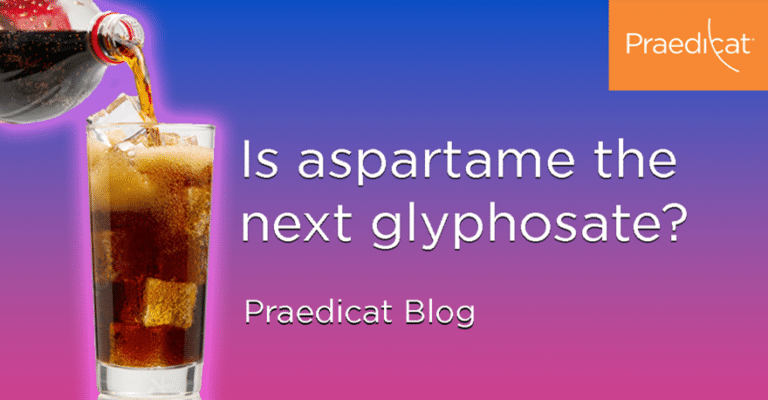Praedicat Blog – Is aspartame the next glyphosate?
by Adam Grossman and Sheryll Mangahas
In March 2015, the World Health Organisation’s (WHO) International Agency for Research on Cancer (IARC) declared that glyphosate, the active ingredient in Roundup, was “probably” carcinogenic to humans. Within months, the first lawsuits were filed seeking to hold Monsanto (now owned by Bayer) responsible for injuries in people exposed to glyphosate. Glyphosate was one of the most popular pesticides at the time, making it easy to find people with high exposure, and nearly every complaint referenced the IARC decision naming it as probably carcinogenic.
We all know how that litigation ended: with Bayer paying $10 billion to settle most of the cases.
Fast forward to July 2023 and IARC is looking at another chemical with broad exposure: aspartame, one of the most commonly used non-nutritive sweeteners. Like glyphosate, aspartame has a history of controversy that began not long after its approval and concerns about its health effects have lingered since the 1970s. Also, like glyphosate, the concerns lingered despite scientific evidence saying that it’s safe as used in soft drinks. Perhaps some of the suspicion stems from the fact that Monsanto owned the original brand of aspartame (NutraSweet) from 1985 to 2000.
Nonetheless, when IARC announced that it would be evaluating the carcinogenicity of aspartame in early 2023, our alarm bells rang at Praedicat. Could IARC decide that aspartame was “probably” carcinogenic despite the evidence suggesting that the risk to any individual was small? If they did, would it lead to litigation in the same way that their glyphosate classification did?
Thankfully for all involved, IARC seems to have taken note of the consequences of its glyphosate decision. Aside from the immense cost to Monsanto/Bayer, IARC was heavily scrutinized, and even vilified in many circles, for their perceived agenda. IARC’s process for aspartame appears to have, at least for now, averted the likelihood of mass litigation claiming that aspartame from soft drinks caused cancer.
Aspartame was rated as “possibly” carcinogenic to humans, one step below the rating that glyphosate received.
To understand how they reduced the likelihood of their decision leading to unintended consequences, it’s helpful to review the regulatory decisions regarding aspartame. Like many food additives, aspartame has been subject to scientific examination by regulators in the US, EU, and elsewhere. Those regulators have determined, using the same scientific information as IARC, that it’s safe to ingest as much as 40-50 mg or aspartame each day per kilogram of body weight. That equates to at least 15 cans of soda per day for an average adult. IARC’s review of aspartame’s carcinogenicity could have led the general public to distrust the published acceptable intake limits, and so they paired with the WHO’s Joint Expert Committee on Food Additives (JECFA) to reevaluate the acceptable intake limits concurrently with their carcinogenicity review.
In a smart piece of public relations, the two bodies from the WHO released their findings jointly: IARC proclaimed that aspartame is “possibly” carcinogenic while JECFA reaffirmed its prior conclusions that a 40 mg/kg acceptable daily intake (ADI) is safe. Nonetheless, they arrived at their conclusions using different methods.
IARC reviewed 1300 studies for their aspartame analysis. They ended up focusing primarily on 3 human epidemiology studies that examined whether artificially sweetened beverage intake led to increased cancer incidence. These studies concluded that there was an association between artificially sweetened beverage intake and liver or pancreatic cancers. According to IARC’s methodology they also assessed the reliability of the studies and determined that chance, bias, or confounding could not be ruled out as an explanation for the association. That led them to conclude that there was “limited” evidence for cancer in human studies. They similarly ascertained there is “limited” evidence from both animal and in vitro studies to support an association between aspartame and cancer. IARC’s rubric then required them to rate aspartame as “possibly carcinogenic to humans.” This designation by IARC was confidentially shared with JECFA before they held their meeting in early July.
JECFA’s analysis focused on studies investigating aspartame because they judged artificially sweetened beverage intake to be a mediocre proxy for aspartame intake. JECFA relied heavily on the fact that aspartame fully hydrolyzes in the gastrointestinal tract into its primary metabolites (the amino acids phenylalanine and aspartic acid, and methanol) and does not enter the bloodstream as aspartame. These 3 chemicals are common constituents of food and are commonly released by the hydrolysis of many foods. JECFA also noted that blood levels of aspartame’s metabolites do not increase after ingestion of aspartame at the current ADI. They also concluded that the evidence from human and animal studies finding that aspartame is harmful was “not convincing.” Finally, JECFA examined in vitro and in vivo genotoxicity studies, finding that aspartame is not genotoxic.
The coordination between IARC and JECFA has helped ensure that despite IARC’s finding of “possible” carcinogenicity, the public is unlikely to react with the level of concern it had with glyphosate – despite the Monsanto connection. This doesn’t mean, of course, that creative plaintiff lawyers won’t try to find a way to turn IARC’s finding into litigation despite JECFA’s statement. But if they do, they will have a less convincing argument than did the glyphosate lawyers.
Author’s note: In the researching of this blog, our team discovered quite a few surprises on the IARC’s list of what else might be possibly carcinogenic (Group 2b). Some of these unexpected items include aloe vera, gingko biloba, radio-frequency fields, moth balls and Asian pickled vegetables. If you share our adoration of kimchi and zha cai, this BBC article is a good read.
Contact a member of our team to talk about our emerging interest risks

